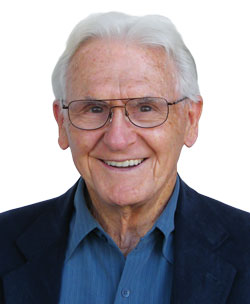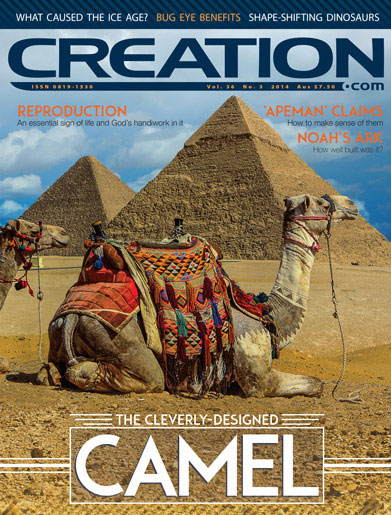Medical pioneer: creation ‘foundational’
Don Batten chats with Bernard Brandstater MB, BS, FRCA, FANZCA, FACA, Professor of Anesthesiology, Loma Linda University.

Graduating in medicine from Adelaide University (Australia), Dr Bernard Brandstater, just married, worked his way across the Pacific as a ship’s surgeon to gain postgraduate training in the US and then the UK. Invited to join the teaching faculty at the medical school of the American University of Beirut in 1956, Bernard with his wife Neridah, their two infant daughters, and lots of baby food, drove 8,000 km (5,000 miles) through Western and Eastern Europe, still in post-war shambles, plus Turkey and Syria, to Beirut!
After only a year, the dean appointed Bernard as the first chairman of the new department of anesthesiology—at age 28, the youngest chairman and associate professor in the University. In time, this became the only department anywhere that both the American Board of Anesthesiology and the Royal College of Anaesthetists in London recognized for postgraduate training of physicians.
Bernard found Beirut to be a fascinating, congenial place to practise medicine and teach. Two years stretched into thirteen and in that time, he:
- Organized and hosted the first congress of anesthesiologists in the Middle East: 127 specialists and professors from 23 different countries.
- Founded the Middle East Journal of Anaesthesiology, still going strong today.
- Gave the first epidural anesthesia in the Middle East; gave the first thousand himself, on-call day and night for a long time.
- Designed a novel multiple-aperture epidural catheter that became used world-wide.
- Introduced positive-pressure artificial respiration, replacing obsolete tank respirators.
- Had the first survivals recorded anywhere of babies with tetanus of the newborn.
- Introduced prolonged intubation1to assist infant breathing.2 This landmark technology spread rapidly. It triggered the quick appearance of neonatal intensive care units around the world. Dr Brandstater was invited to present a lecture on this at a 2013 conference at Sydney University.
- Was emergency medical consultant for King Saud of Saudi Arabia. He gave anesthesia to three of his queens, plus other VIPs.
- Designed and inaugurated the surgery suite at the new University Hospital. Hundreds of casualties from the Lebanese civil war were treated there.
- Lived through the dramatic 1967 Six-Day War between Israel and the surrounding Arab nations. Refugees flooded into Lebanon, and sadly they helped to disrupt the delicate politico-religious balance in Lebanon.
- In 1969 was appointed a professor of anesthesiology at Loma Linda University, California. He again served as founding chairman of a new department, which is now large and influential.
- Founded an anesthesia program for dentistry, now a model for programs elsewhere. He also inaugurated the Loma Linda Pain Clinic; and there’s much more!
Now in his 80s, but young at heart, and gratefully healthy, Dr Brandstater considers himself ‘half-retired’, but he still does part-time operating theatre work.
Spiritual life
The son of a pastor, Bernard grew up in a church community where young people were encouraged in Bible reading, worship leading, and making music in church. So, quite early he was involved in youth leadership. Even as a 20-year-old medical student, he was called to preach in various places.
Bernard shared, “When I started medicine at Adelaide University, having just turned sixteen, my father gave me good advice: because the University was filled with many who had little time for God, I should join a Christian club, and befriend some fellow students who were genuine Christians. They would help me resist the God-ignoring influences around me. I joined the Evangelical Union, the local chapter of Inter-Varsity Fellowship (IVF). We enjoyed weekly prayer meetings, and occasional weekend country retreats where we would do Bible study, sing our heads off, and have a marvellous time. It was great Bible study, in which I learned to respect understandings of Scripture that were a bit different from mine. Regardless of church background, these students loved Jesus as Lord as much as I did.”
Dr Brandstater has been actively involved in Christian witness on campuses ever since. At Loma Linda, California, he was elected head elder of the 5,000-member campus church, with 2,000 students and staff attending Wednesday lunch-time chapel services.
He also spoke of the ongoing challenge in the university, including in its busy 800-bed hospital, to maintain a “spirit of Good Samaritan service, and a forthright, warm Christian kind-heartedness in the face of time pressures and a need for efficiency.”
Bernard instigated training in personal evangelism for clinical staff, getting Bill Bright, the founder of Campus Crusade for Christ, personally involved. Bernard remarked, “It was a major challenge to persuade senior, know-it-all, dignified professors to stoop to the simple, self-disclosing talk of witnessing. When dealing with sick, vulnerable people, there is a sensitive ethical issue in faith-sharing when there is a sharp power imbalance between the parties.”
The importance of Creation
From his early years as a student, the tension between biblical faith and evolutionary theory was often discussed, and gradually Bernard became more informed. He says, “I have increasingly come to regard Creation as foundational to knowledge of God. He made us. That’s His identity: the Creator, the sovereign Lord of the universe.”
“In biblical times, alongside competing pagan gods, the one true God was the Creator-God. That’s how Jonah identified God to the pagan Phoenician seamen terrified in an ocean storm: ‘the God of heaven who made the sea and the dry land’ (Jonah 1:9). On Mars Hill, the apostle Paul, addressing pagans, identified their unknown God as the ‘God who made the world and everything in it’ (Acts 17:24). So the supreme deity was the Creator-God. Even among heavenly beings, creative power is again the hallmark of God alone. In Revelation 4:11 the twenty-four worshiping elders declare: ‘Worthy are you, our Lord and God, to receive glory and honour and power, for you created all things.’ God’s creatorship is the basis for his sovereignty over the universe. He is the supreme Lord over all.
“The Bible says, ‘God saw everything that he had made, and it was very good’ (Genesis 1:31). The original earth was splendid beyond our imagining, with its variety, its balance, its coherence as a living system. With its precise physical laws holding it together, from the immensity of space to the smallest Planck particle, it delighted its Creator. So, creation shows us God’s character: He is a personal God, worthy of our love and trust and worship.
“Eden was perfect above anything we can imagine. The picture we have of the future restored New Earth tells us how it was in the beginning: ‘There will be no more death or mourning or crying or pain, for the old order of things has passed away’ (Revelation 21:4). So Eden had no sorrow, pain, or misery, and no predatory animals. God gave our first parents a vast potential for a rich unfolding future, as they exercised their dominion over planet Earth (Genesis 1:28).”
Long ages / deep time?
“The Creation is described as a brief, time-limited event, with a clean ending on Day Six and a celebration the following day. Dare we add a drawn-out process that distorts this splendid picture? Some people try to do so, adding long ages of evolutionary time; it’s thought that vast time is necessary to allow for evolution; but Darwinism with its long ages is now being strongly questioned. Why should we bow to such conjectures?
“Extended time distorts our view of both the creation and God. Considering the Creator’s goodness, it is hard to consider millions of years of savage, competitive, evolutionary existence, with death as an ugly reality, supposedly needed to weed out the unfit. God’s mode of creating tells us about His mind, His heart. In the Bible there is no hint of a long incubation. ‘He spoke and it was done’ (Psalm 33:9, NASB).
“That sounds like a finished work, like completion, not an ongoing process. And it was said to be ‘very good’ when the job was finished (Genesis 1:31).”
The Fall
“Evil and death certainly exist today, but they came later, not as part of God’s original creation. They were the tragic result of the Fall; mankind’s disobedience (Genesis 3, Romans 8). A creation that deserves a central place in our worldview cannot include a long process that is abhorrent to us, with millions of years of death, ‘the last enemy’ (1 Corinthians 15:26). It is not compatible with the expansive, loving and triumphant narrative told in the Bible. The process of creation should fit the character and purposes of a God who does all things well,3 who is generous and merciful, and who delights in beauty. This is the God we can trust, seek to know and even love.”
Bernard the adventurer

In 1988 Bernard served as a crew member on a tall ship in the ‘First Fleet’ re-enactment of the voyage from England to Australia 200 years before. He remarked, “Scaling the rigging and working the sails fifty feet above the deck in the rough ‘Roaring Forties’ was a bit outside my comfort zone. It was white knuckle time.”
He also climbed the Matterhorn in Switzerland, and also Argentina’s Aconcagua, the highest mountain outside Asia. He also climbed to Base Camps on both the Nepalese and Tibetan sides of Mt Everest. These experiences aroused his scientific interest in the human body’s response to thin air and how this shows the magnificent design of our bodies:
“It is amazing to see how quickly chemo-receptors in our neck respond to lower oxygen levels at high altitude. Nerve signals increase breathing rate to raise our oxygen levels. But over-breathing can push carbon dioxide levels too low, so another mechanism comes to the rescue: active ion transport across the blood-brain barrier, affecting hydrogen ions in the cerebrospinal fluid. That requires cellular energy to drive ions against the normal gradient. These subtle chemical adjustments happen automatically, to keep our body chemistry safe. Without them we would have dangerous swings of acid-base balance (pH). A wise, supra-human chemist had to have invented such controls to maintain us within an optimal range of pH.”
Editorial note: RIP Dr Brandstater (23 Feb 1929 – 17 Jan 2020). Dr Brandstater passed away peacefully a few weeks from his 91st birthday. Bernard is survived by his wife, Beverly Brandstater; daughter Suzanne Thomas; daughter Karry Roland; son Nigel Brandstater; and daughter Elizabeth Shaw; and 7 grandchildren.
References and notes
- Intubation: insertion of a tube into the windpipe (trachea) to assist breathing. Return to text.
- Brandstater, B., Prolonged intubation: an alternative to tracheostomy in infants, Survey of Anesthesiology 8(4):355, 1964. See also, Prolonged per-laryngeal endotracheal intubation in children: 40 years on, Anaesthesia & Intensive Care 31(6):664–666; discussion 663–664, 2003. Return to text.
- Mark 7:37, speaking of Jesus, God Incarnate. Return to text.






Readers’ comments
Comments are automatically closed 14 days after publication.